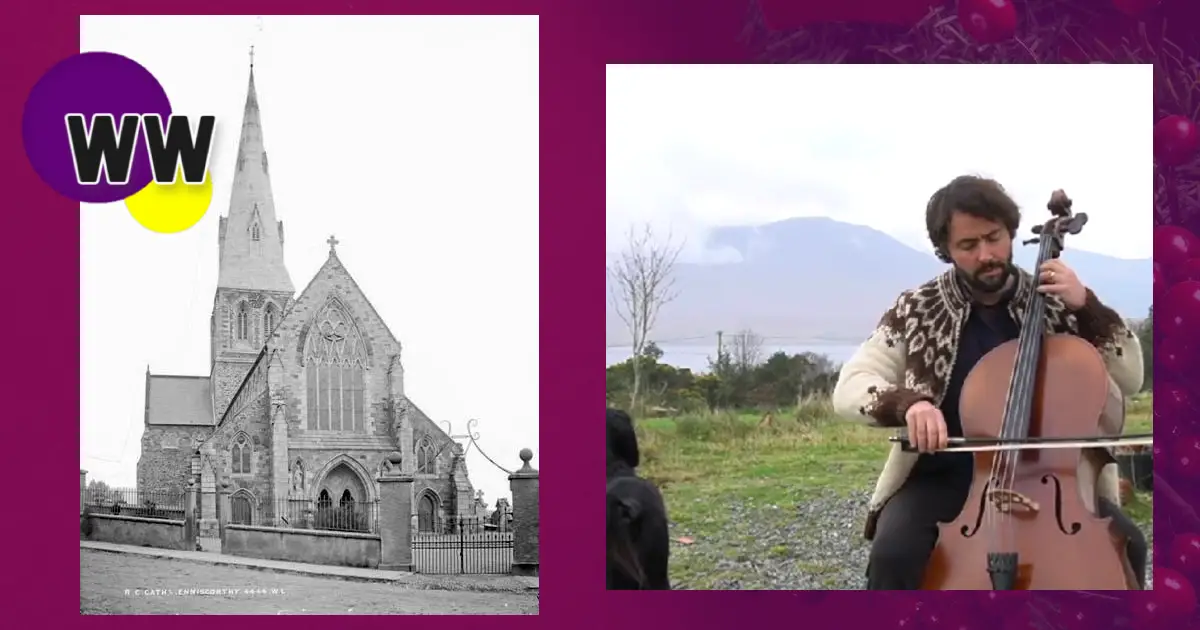December is once more upon us and as such we have seen a return to the jubilant atmosphere of Christmas time in Wexford…
The Main Street is once more alight with the radiant, bright and joyful lights which have become a very familiar sight to all familiar with Christmas in Wexford. So too is the Quay illuminated with spectacular and dazzling lights, striking reds and green reflected in the calm waters and piercing through the windows of cars stuck in the seasonal heavy traffic. The streets are bustling and a great atmosphere of liveliness, excitement and general good cheer descends upon the town. There truly is nothing quite like Christmas in Wexford.
An equally familiar facet of Christmas in Wexford is the music which fills the streets whether it be carollers singing traditional Christmas songs or the smooth voice of Bing Crosby or the upbeat tunes of the Pogues blasting from the speakers.
But never mind White Christmas, Jingle Bells or Fairytale of New York, Wexford has made a contribution to the world of festive songs which far outdates much, if not all, of which you’ll hear this Yuletide.
The Wexford Carol:
Many of a certain generation and younger would be unfamiliar with the Wexford Carol or the Enniscorthy Carol as it is otherwise known. The carol is said to have been composed around the 12th century which is remarkable and this would make it one of the oldest surviving Christmas songs.
There are a few notable and surprising facts about the song and its composition. The song was composed at a time in Ireland when Irish was the predominantly spoken language, yet it is said that lyrics in English are the lyrics as they were originally composed.
An Irish translation, ‘an Carúl Loch Garman’, does exist and was widely used, however it is merely a translation of the original lyrics. Of course, for many years Irish remained the most widely spoken language in the country and as such, the Irish lyrics of the popular carol were widely used. As the years dragged on the Anglicisation of Ireland became more widespread and as the language began to fade, so too did the lyrics in Irish for ‘an Carúl Loch Garman’ begin to fade with it. However, we still have the lyrics and there are of course many who still enthusiastically indulge in a rendition of ‘an Carúl Loch Garman’ at Christmastime.
It is also said that music for the song was composed after the lyrics. In fact, it is said that the lyrics predate the music by centuries. Various sources have suggested that the familiar tune was composed in the 15th of 16th century, nearly 300-400 years after the lyrics were written. It is estimated that the music was composed around this time due to its style which heavily indicates that it was a creation of that time.
The song details the Christian story of the Nativity, it speaks of the arrival of Mary and Joseph to Bethlehem, the birth of Jesus Christ in a “humble ox’s stall” and the arrival of the three wise men to present their gifts.
The lyrics are as follows:
THE WEXFORD CAROL LYRICS:
Good people all, this Christmas time,
Consider well and bear in mind
What our good God for us has done
In sending His beloved Son
With Mary holy we should pray,
To God with love this Christmas Day
In Bethlehem upon that morn,
There was a blessed Messiah born.
The night before that happy tide,
The noble virgin and her guide
Were long time seeking up and down
To find a lodging in the town.
But mark how all things came to pass
From every door repelled, alas,
As was foretold, their refuge all
Was but a humble ox’s stall.
Near Bethlehem did shepherds keep
Their flocks of lambs and feeding sheep
To whom God’s angels did appear
Which put the shepherds in great fear
Prepare and go, the angels said
To Bethlehem, be not afraid
For there you’ll find, this happy morn
A princely Babe, sweet Jesus, born.
With thankful heart and joyful mind
The shepherds went the babe to find
And as God’s angel had foretold
They did our Saviour Christ behold
Within a manger He was laid
And by his side the virgin maid
Attending on the Lord of Life
Who came on earth to end all strife.
There were three wise men from afar
Directed by a glorious star
And on they wandered night and day
Until they came where Jesus lay
And when they came unto that place
Where our beloved Messiah lay
They humbly cast them at His feet
With gifts of gold and incense sweet.
Like many Christmas carols of its time, it began to decrease in popularity and began to slowly fade into obscurity. It may well have met the same fate as so many other traditional Christmas carols of its time were it not one man, William Henry Grattan Flood.
William Henry Grattan Flood:
Early Life:
W.H. Grattan Flood was born in Lismore, county Waterford on the 1st of November 1857. Grattan was born into a relatively wealthy family, high up in the social hierarchy of the time. His father William and mother Catherine were the master and matron of the Lismore Union Workhouse. William was born into a large family of seven children, six boys and one girl.
He received his primary education at a school called the boy’s academy in Lismore, which was run by his grandfather. Grattan would go on to earn his fame largely through his involvement in the world of music. He displayed an aptitude for music from a very early age and was already a renowned pianist by the tender age of 9.
Performance for the Duke:
Even at such a young age, his reputation was so great that he gave a recital for the Duke of Devonshire at Lismore castle. The Dukedom of Devonshire was held by the Cavendish family. Their influence in British society and their wealth at the time was near enough to unrivalled; very few aristocratic families of the time held the same influence and so it must have been viewed as a great honour to receive an invitation from the Duke to perform.
The Dukes of Devonshire tended to hold positions of great political influence. The Duke that William performed for William Cavendish was an MP for Cambridge University, Malton and North Derbyshire, Chancellor of both Cambridge University and the University of London and Lord Lieutenant of Lancashire and Derbyshire, as such it’s clear to see William’s talents had come to the attention of very influential figures.
Education and Career:
He received his secondary education at Mount Mellleray and was mentored by famous Irish composer Sir Robert Prescott Stewart. Grattan Flood was a devout Catholic and received a third level education at St. Patrick’s College in Carlow where he studied in the priesthood, however W.H. Grattan Flood was not destined for the clergy.
William was a prolific writer and authored a vast amount of books on the history of Irish music. He also composed a significant amount of music, mostly for religious purposes. He also worked as a music teacher at the Jesuits College in Tullabeg in county Offaly and at the far famed St. Kieran’s College, Co. Kilkenny.
Grattan Flood was able to combine his love for music and his commitment to his faith when took up the role as organist at various cathedrals across the country. He served as organist in Belfast, Thurles and Monaghan, however his most prolific period as a musicologist, historian and composer came when he served in St. Aidan’s Cathedral, Enniscorthy.
It was also his time in Enniscorthy that breathed life back into the ailing Wexford carol. The carol had never been written down, and so beyond the locality, it didn’t enjoy great renown or popularity. However W.H. Grattan Flood and his keen musical ear must have been allured by the Wexford Carol.
Its musical and religious significance would have no doubt to him. He transcribed the carol from a local singer and had it published in the Oxford Book of Carols. The Oxford Book of Carols was very widely distributed and the Wexford Carol became very popular once more not only in Ireland, but worldwide.
W.H. Grattan Flood would go on to have the Papal Cross, Pro Ecclesia Et Pontifice, bestowed upon him in 1917 by Pope Benedict XV, which is an award which was given for extraordinary service to the church from either laypeople or members of the clergy.
In 1922, Pope Gregory elevated this honour to the Order of St. Leo and granted the title of Chevalier to Grattan Flood. Grattan Flood is viewed as a pivotal figure in the history of Irish music and the revival of the Wexford Carol or the Enniscorthy Carol (as it became known due to his transcription of the carol in Enniscorthy) was among his most celebrated achievements.
The Wexford Carol today:
The worldwide fame of the carol endured many famous names have lent their voice or their musical skill to the carol. Julie Andrews, Academy Award winning actress, star of Mary Poppins and the Sound of Music recorded a rendition of the song in 1966. Other renowned singers such as Tom Jones have given their own renditions of the songs.
Renowned American Cellist Yo Yo Ma and Allison Kraus recorded the song for Ma’s Christmas album ‘Songs of Joys and Peace’ in 2008. The carol is to this day beloved by many and synonymous with Christmastime, yet for those of a younger generation, the song is mostly unknown.
Perhaps this Christmas between Wham! or Slade you may hear a cheerful rendition of Wexford’s centuries old Christmas Carol in the county of its origin.
Nollaigh shona daoibh.
Sources used:
The Wexford Carol – History and Lyrics (liveabout.com)
The Wexford Carol – Ireland’s greatest Christmas song – Ireland Calling (ireland-calling.com)
The Wexford Carol / Carúl Loch Garman — Celtic Studies Resources (digitalmedievalist.com) Flood, William Henry Grattan | Dictionary of Irish Biography (dib.ie)
Read also:
It’ll Be A Great Day Of Sport For Wexford GAA Fans On Saturday
Oulart Final And Shelmaliers Game To Be Broadcasted Live On TV
Read also:
Contact us now to advertise via Wexford Weekly’s Christmas Campaign! Email our team at info@wexfordweekly.com



One Reply to “”